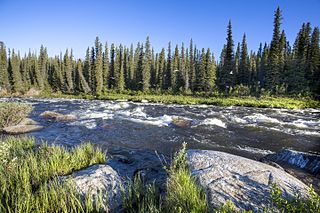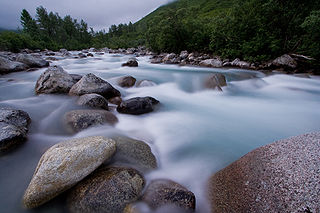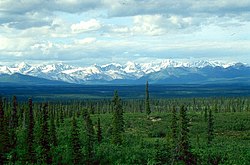
Cantwell is a census-designated place (CDP) in Denali Borough, Alaska, United States. As of the 2020 census, the population of the CDP was 200.

Talkeetna is a census-designated place (CDP) in Matanuska-Susitna Borough, Alaska, United States. At the 2020 census the population was 1,055, up from 876 in 2010.

Glennallen is a census-designated place (CDP) in the Copper River Census Area in the Unorganized Borough of the U.S. state of Alaska. As of the 2020 census, the population of the CDP was 439, down from 483 in 2010. It is the most populated community in the census area.

The Alaska Range is a relatively narrow, 600-mile-long (950 km) mountain range in the southcentral region of the U.S. state of Alaska, from Lake Clark at its southwest end to the White River in Canada's Yukon Territory in the southeast. Denali, the highest mountain in North America, is in the Alaska Range. The range is part of the American Cordillera.

Denali National Park and Preserve, formerly known as Mount McKinley National Park, is a United States national park and preserve located in Interior Alaska, centered on Denali, the highest mountain in North America. The park and contiguous preserve encompass 6,045,153 acres which is larger than the state of New Hampshire. On December 2, 1980, 2,146,580-acre Denali Wilderness was established within the park. Denali's landscape is a mix of forest at the lowest elevations, including deciduous taiga, with tundra at middle elevations, and glaciers, snow, and bare rock at the highest elevations. The longest glacier is the Kahiltna Glacier. Wintertime activities include dog sledding, cross-country skiing, and snowmobiling. The park received 594,660 recreational visitors in 2018.

The Susitna River is a 313-mile (504 km) long river in the Southcentral Alaska. It is the 15th largest river in the United States, ranked by average discharge volume at its mouth. The river stretches from the Susitna Glacier to Cook Inlet's Knik Arm.

The Nenana River is a tributary of the Tanana River, approximately 140 miles (230 km) long, in central Alaska in the United States. It drains an area on the north slope of the Alaska Range on the south edge of the Tanana Valley southwest of Fairbanks.

The George Parks Highway, usually called simply the Parks Highway, runs 323 miles (520 km) from the Glenn Highway 35 miles (56 km) north of Anchorage to Fairbanks in the Alaska Interior. The highway, originally known as the Anchorage-Fairbanks Highway, was completed in 1971, and given its current name in 1975.

The Alaska Railroad is a Class II railroad that operates freight and passenger trains in the state of Alaska. The railroad's mainline runs between Seward on the southern coast and Fairbanks, near the center of the state. It passes through Anchorage and Denali National Park, to which 17% of visitors travel by train.

The Gulkana River is a 60-mile (97 km) tributary of the Copper River in the U.S. state of Alaska. Beginning near the southeastern end of Summit Lake in the Alaska Range, the river flows generally south to meet the larger river 9 miles (14 km) northeast of Glennallen. The Richardson Highway and the Trans-Alaska Pipeline run north–south, nearby and roughly parallel to the Gulkana River. Slightly south of Summit Lake the river passes under the east–west Denali Highway near its junction with the Richardson Highway at Paxson.

Denali State Park is a 325,240-acre (131,620 ha) state park in the U.S. state of Alaska. It is located in the Matanuska-Susitna Borough adjacent to the east side of Denali National Park and Preserve, along the Parks Highway.

Little Susitna River (Dena'ina: Tsałtastnu) heads at Mint Glacier on Montana Peak, in Talkeetna Mountains at 61°51′30″N149°03′30″W, flows southwest to Cook Inlet, 13 miles (21 km) west of Anchorage, Alaska Cook Inlet Low.

Alaska Route 1 (AK-1) is a state highway in the southern part of the U.S. state of Alaska. It runs from Homer northeast and east to Tok by way of Anchorage. It is one of two routes in Alaska to contain significant portions of freeway: the Seward Highway in south Anchorage and the Glenn Highway between Anchorage and Palmer.
The Teklanika River is a 91-mile (146 km) tributary of the Nenana River in the U.S. state of Alaska. The Nenana is a tributary of the Tanana River, which is part of the Yukon River drainage in the central interior region of the state. Flowing northward from headwaters at the Cantwell Glacier in the Alaska Range, the Teklanika drains an area widely visited by tourists to Denali National Park and Preserve. The park's only road crosses the river at milepost 31 and a National Park campground is located on its eastern bank at milepost 29.

The 2002 Denali earthquake occurred at 22:12:41 UTC November 3 with an epicenter 66 km ESE of Denali National Park, Alaska, United States. This 7.9 Mw earthquake was the largest recorded in the United States in 37 years. The shock was the strongest ever recorded in the interior of Alaska. Due to the remote location, there were no fatalities and only one injury.

Isabel Pass is a 40 mile long gap in the eastern section of the Alaska Range which serves as a corridor for the Richardson Highway about 11 miles from Paxson. It is named after Isabelle Barnette, the wife of E. T. Barnette, who helped found Fairbanks. The pass separates four regions, the Tanana Valley to the north, the Delta Mountains to the east, Copper River Basin to the south, and the Hayes Range to the west.

The Tangle Lakes are a 16-mile (26 km) long chain of lakes connected by streams in interior Alaska. They form the headwaters for the Delta River.

Fang Mountain is a 6,736 ft (2,050 m) summit located in the Alaska Range, in Denali National Park and Preserve, in Alaska, United States. It is situated 15 mi (24 km) southwest of park headquarters and 14 mi (23 km) northwest of Cantwell, near the headwaters of the Savage River. This peak's local descriptive name was published in 1952 by the United States Geological Survey. Rarely climbed, Fang Mountain is an unattractive climbing destination because of dangerous, loose, rotten rock and a long approach.

Sugar Loaf Mountain, also known as Sugar Mountain, is a 4,784 ft (1,460 m) summit located in the Alaska Range, near Denali National Park and Preserve, in Alaska, United States. It is situated six miles (9.7 km) northeast of park headquarters and six miles (9.7 km) southeast of Healy. The George Parks Highway and Alaska Railroad traverse the western base of this mountain as each passes through the Nenana River Gorge. Mount Healy, Sugar's nearest higher neighbor, is set 5.2 mi (8 km) to the west across the gorge. This peak's local descriptive name was published in 1950 by the United States Geological Survey.

Mount Healy, also known in Denaʼina language as Dlel Neelghu Nodaadlghunee, is a 5,716-foot elevation mountain summit located in the Alaska Range, in Denali National Park and Preserve, in Alaska, United States. It is situated immediately northwest of park headquarters and six miles (9.7 km) south of Healy. The George Parks Highway and Alaska Railroad traverse the eastern base of this mountain as each passes through the Nenana River Gorge. Mount Healy's nearest neighbor, Sugar Loaf Mountain, is set 5.2 miles (8.4 km) to the east across the gorge, and the nearest higher peak is Fang Mountain, 16.2 mi (26 km) to the south-southwest. Mount Healy is a nine-mile-long, east–west trending ridge system of mostly loose rock with jagged peaks and spires. Vegetation ranges from boreal forest at the base all the way up to barren alpine ridges and snowfields at the top. This area is very popular for day hikes due to its close proximity to the park entrance. This mountain and the town are named after John J. Healy (1840–1908), manager of the North American Trading and Transportation Company. This geographical feature's name was reported in 1921 by Mabry Abbey on his survey map of the boundaries of Mount McKinley National Park.





























